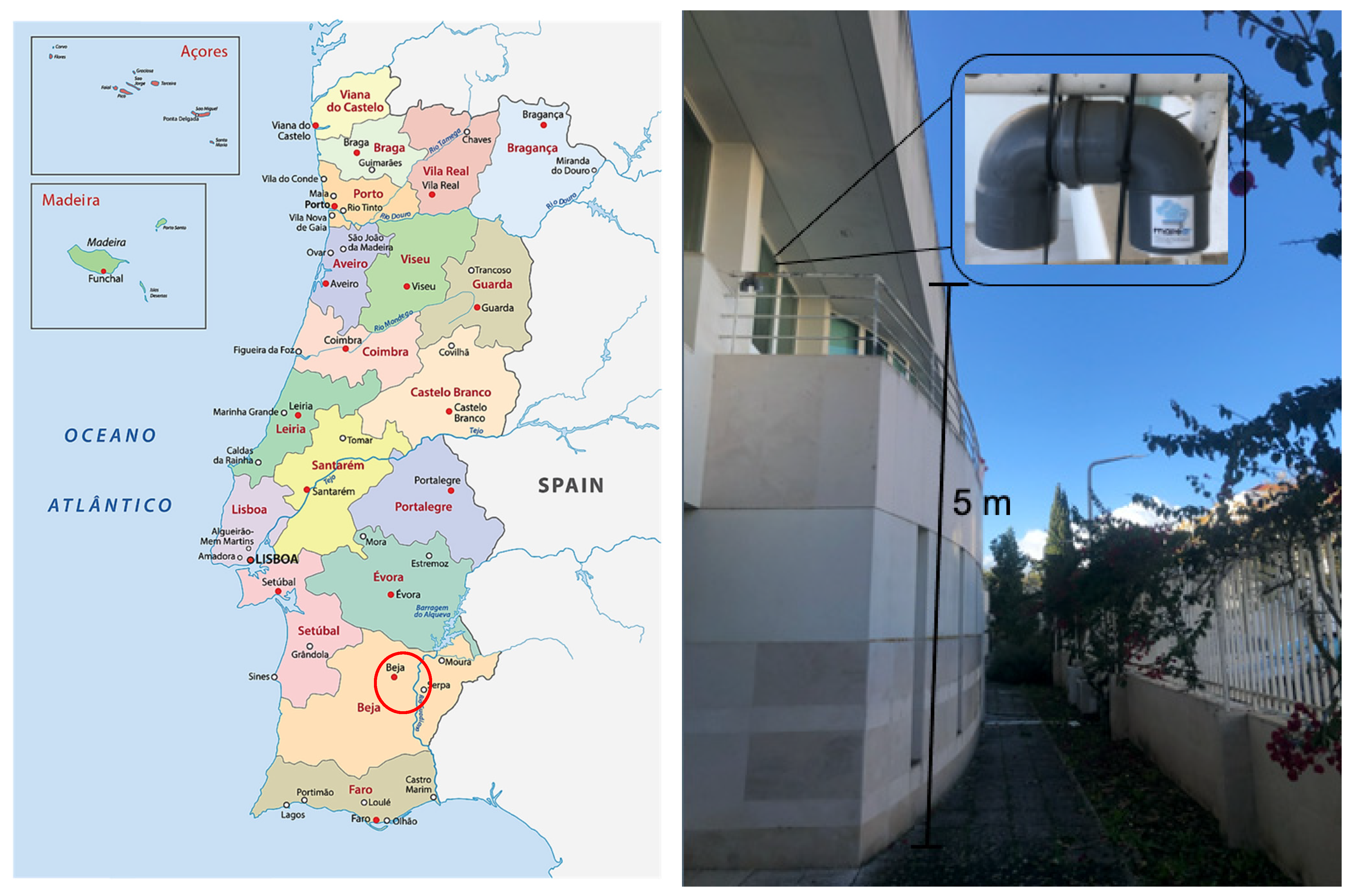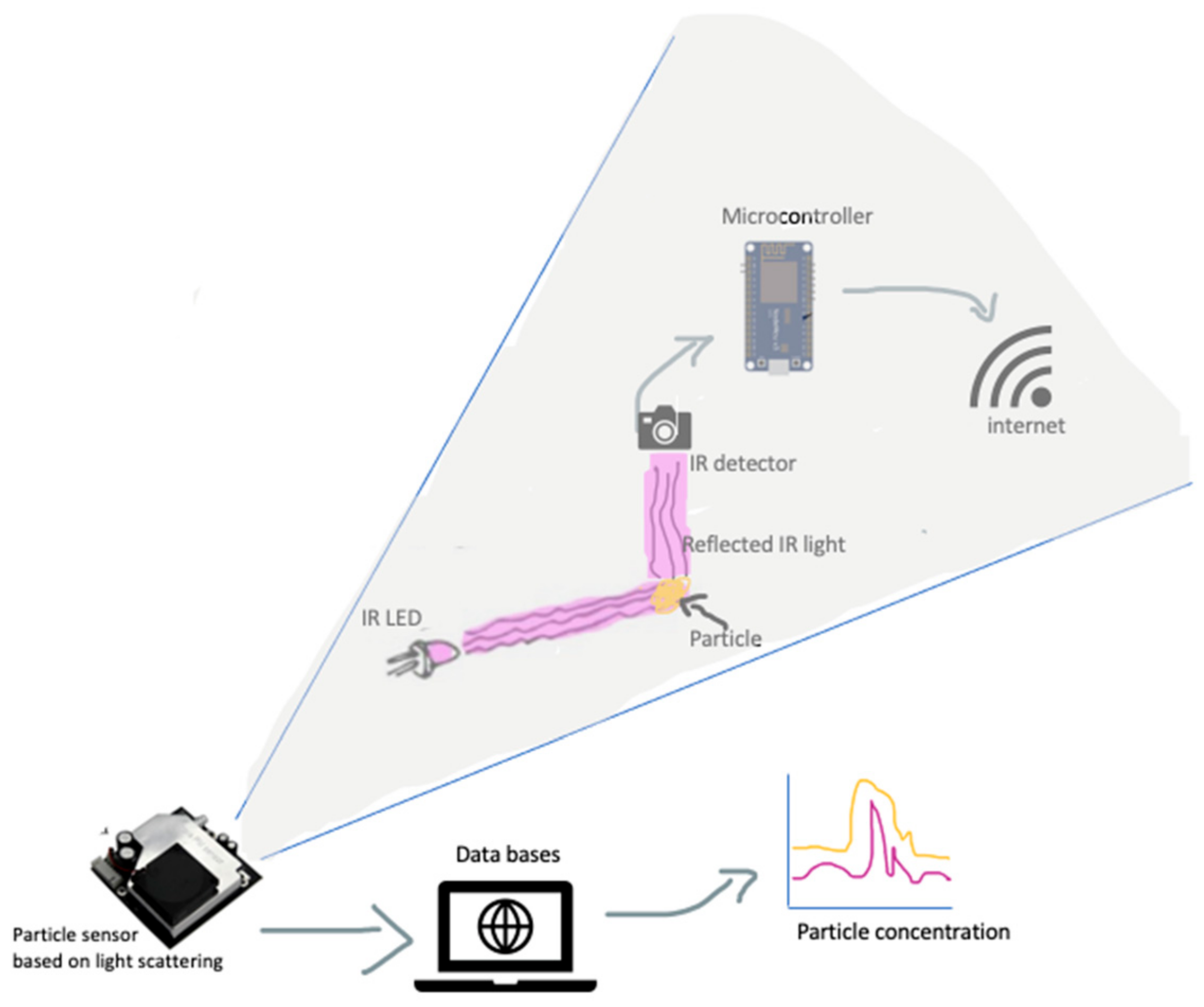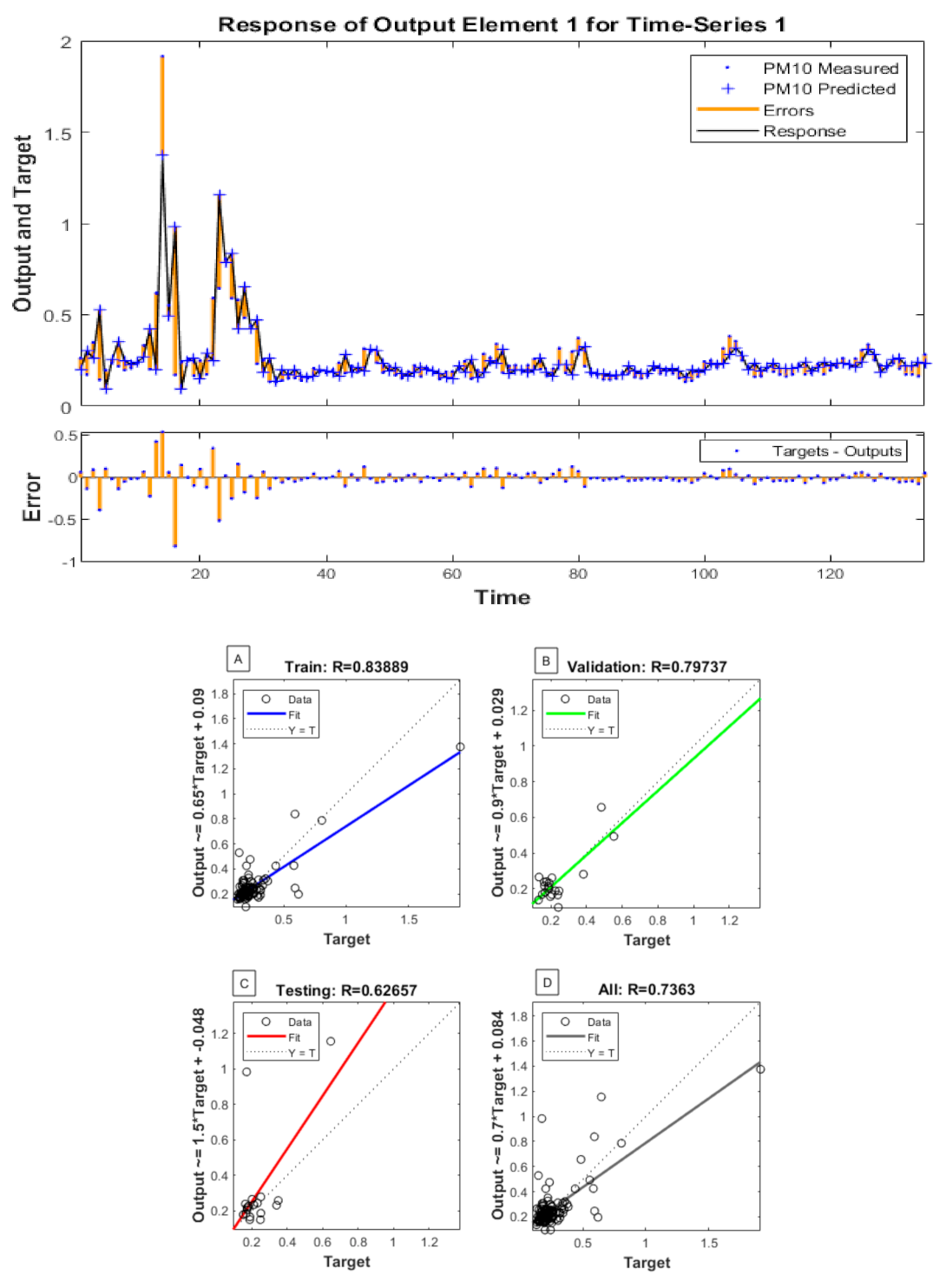Monitoring and Prediction of Particulate Matter (PM2.5 and PM10) around the Ipbeja Campus
Abstract
1. Introduction
2. Materials and Methods
NARX Predictive Models
3. Results and Discussion
NARX Predictive Models
4. Conclusions
Author Contributions
Funding
Institutional Review Board Statement
Informed Consent Statement
Data Availability Statement
Acknowledgments
Conflicts of Interest
References
- Tan, Y.; Han, S.; Chen, Y.; Wu, Z.; Lee, S. Long-term variation and evaluation of air quality across Hong Kong. J. Environ. Sci. 2023, 127, 284–294. [Google Scholar] [CrossRef] [PubMed]
- Kim, K.H.; Kabir, E.; Kabir, S. A review on the human health impact of airborne particulate matter. Environ. Int. 2015, 74, 136–143. [Google Scholar] [CrossRef] [PubMed]
- Liu, Z.R.; Hu, B.; Ji, D.S.; Cheng, M.T.; Gao, W.K.; Shi, S.Z.; Xie, Y.Z.; Yang, S.H.; Gao, M.; Fu, H.B.; et al. Characteristics of fine particle explosive growth events in Beijing, China: Seasonal variation, chemical evolution pattern and formation mechanism. Sci. Total Environ. 2019, 687, 1073–1086. [Google Scholar] [CrossRef] [PubMed]
- Schornobay-Lui, E.; Alexandrina, E.C.; Aguiar, M.L.; Hanisch, W.S.; Corrêa, E.M.; Corrêa, N.A. Prediction of short and medium term PM10 concentration using artificial neural networks. Manag. Environ. Qual. Int. J. 2019, 30, 414–436. [Google Scholar] [CrossRef]
- World Health Organization (WHO). Health Topics: Chronic Respiratory Diseases? Available online: https://www.who.int/health-topics/chronic-respiratory-diseases#tab=tab_1 (accessed on 22 June 2022).
- Schraufnagel, D.E.; Balmes, J.R.; Cowl, C.T.; De Matteis, S.; Jung, S.H.; Mortimer, K.; Perez-Padilla, R.; Rice, M.B.; Riojas-Rodriguez, H.; Sood, A.; et al. Air pollution and noncommunicable dis- eases: A review by the forum of international respiratory societies’ environmental committee, part 1: The damaging effects of air pollution. Chest 2019, 155, 40916. [Google Scholar] [CrossRef]
- Thurston, G.D.; Kipen, H.; Annesi-Maesano, I.; Balmes, J.; Brook, R.D.; Cromar, K.; de Matteis, S.; Forastiere, F.; Forsberg, B.; Frampton, M.W.; et al. A joint ERS/ATS policy statement: What con- stitutes an adverse health effect of air pollution? An analytical framework. Eur. Respir. J. 2017, 49, 1600419. [Google Scholar] [CrossRef]
- Dominski, F.H.; Branco, J.H.L.; Buonano, G.; Stabile, L.; da Silva, M.G.; Andrade, A. Effects of air pollution on health: A mapping review of systematic reviews and meta-analyses. Environ. Res. 2021, 201, 111487. [Google Scholar] [CrossRef]
- Watson, J.G.; Chow, J.C. Source characterization of major emission sources in the Imperial and Mexicali valleys along the US/Mexico border. Sci. Total Environ. 2001, 276, 33–47. [Google Scholar] [CrossRef]
- Sternbeck, J.; Sjödin, A.; Andréasson, K. Metal emissions from road traffic and the influence of resuspension—Results from two tunnel studies. Atmos. Environ. 2002, 36, 4735–4744. [Google Scholar] [CrossRef]
- Pikridas, M.; Tasoglou, A.; Florou, K.; Pandis, S.N. Characterization of the origin of fine particulate matter in a medium size urban area in the Mediterranean. Atmos. Environ. 2013, 80, 264–274. [Google Scholar] [CrossRef]
- Castanho, A.D.A.; Artaxo, P. Wintertime and summertime São Paulo aerosol source apportionment study. Atmos. Environ. 2001, 35, 4889–4902. [Google Scholar] [CrossRef]
- Badura, M.; Sówka, I.; Szymański, P.; Batog, P. Assessing the usefulness of dense sensor network for PM2.5 monitoring on an academic campus area. Sci. Total Environ. 2020, 722, 137867. [Google Scholar] [CrossRef] [PubMed]
- Jakeman, A.J.; Simpson, R.W.; Taylor, J.A. Modeling distributions of air pollutant concentrations–III. The hybrid deterministic-statistical distribution approach. Atmos. Environ. 1988, 22, 163–174. [Google Scholar] [CrossRef]
- Adnane, A.; Leghrib, R.; Chaoufi, J.; Chirmata, A. Prediction of PM10 concentrations in the city of Agadir (Morocco) using non-linear autoregressive artificial neural networks with exogenous inputs (NARX). Mater. Today Proc. 2022, 52 Pt 1, 146–151. [Google Scholar] [CrossRef]
- Dhafer, A.H.; Nor, F.M.; Alkawsi, G.; Al-Othmani, A.Z.; Shah, N.R.; Alshanbari, H.M.; Khairi, K.F.B.; Baashar, Y. Empirical Analysis for Stock Price Prediction Using NARX Model with Exogenous Technical Indicators. Comput. Intell. Neurosci. 2022, 2022, 9208640. [Google Scholar] [CrossRef]
- Yanga, Y.; Kima, K.; Koub, R.; Lib, Y.; Fub, J.; Zhaoa, L.; Liu, H. Prediction of effluent quality in a wastewater treatment plant by dynamic neural network modeling. Process Saf. Environ. Prot. 2022, 158, 515–524. [Google Scholar] [CrossRef]
- Xiaoshu, G.; Cheng, C.; Hetao, H.; Shenghu, J. Response prediction using the PC-NARX model for SDOF systems with degradation and parametric uncertainties. Earthq. Eng. Eng. Vib. 2022, 21, 325–340. [Google Scholar] [CrossRef]
- Moursi, A.S.A.; El-Fishawy, N.; Djahel, S.; Shouman, M.A. Enhancing PM2.5 Prediction Using NARX-Based Combined CNN and LSTM Hybrid Model. Sensors 2022, 22, 4418. [Google Scholar] [CrossRef]
- Bukhari, A.H.; Raja, M.A.Z.; Shoaib, M.; Kiani, A.K. Fractional order Lorenz based physics informed SARFIMA-NARX model to monitor and mitigate megacities air pollution. Chaos Solitons Fractals 2022, 161, 112–375. [Google Scholar] [CrossRef]
- Russo, A.; Sousa, P.M.; Durão, R.M.; Ramos, A.M.; Salvador, P.; Linares, C.; Díaz, J.; Trigo, R.M. Saharan dust intrusions in the Iberian Peninsula: Predominant synoptic conditions. Sci. Total Environ. 2020, 717, 137041. [Google Scholar] [CrossRef]
- Hapidin, D.A.; Saputra, C.; Maulana, D.S.; Munir, M.M.; Khairurrijal, K. Aerosol Chamber Characterization for Commercial Particulate Matter (PM) Sensor Evaluation. Aerosol Air Qual. Res. 2019, 19, 181–194. [Google Scholar] [CrossRef]
- Messeri, G.; Benedetti, R.; Crisci, A.; Gozzini, B.; Rossi, M.; Vallorani, R.; Maracchi, G. A new framework for probabilistic seasonal forecasts based on circulation type classifications and driven by an ensemble global model. Adv. Sci. Res. 2018, 15, 183–190. [Google Scholar] [CrossRef]
- Decreto-Lei n.o 47/2017.Diário da República n.o 90/2017, Série I de 2017-05-10. Available online: https://dre.pt/dre/detalhe/decreto-lei/47-2017-106982550 (accessed on 13 December 2022).
- Zhao, C.S.; Shao, N.F.; Yang, S.T.; Ren, H.; Ge, Y.R.; Zhang, Z.S.; Feng, P.; Liu, W.L. Quantitative assessment of the effects of human activities on phytoplankton communities in lakes and reservoirs. Sci. Total Environ. 2019, 665, 213–225. [Google Scholar] [CrossRef] [PubMed]






Publisher’s Note: MDPI stays neutral with regard to jurisdictional claims in published maps and institutional affiliations. |
© 2022 by the authors. Licensee MDPI, Basel, Switzerland. This article is an open access article distributed under the terms and conditions of the Creative Commons Attribution (CC BY) license (https://creativecommons.org/licenses/by/4.0/).
Share and Cite
Silva, F.M.O.; Alexandrina, E.C.; Pardal, A.C.; Carvalhos, M.T.; Schornobay Lui, E. Monitoring and Prediction of Particulate Matter (PM2.5 and PM10) around the Ipbeja Campus. Sustainability 2022, 14, 16892. https://doi.org/10.3390/su142416892
Silva FMO, Alexandrina EC, Pardal AC, Carvalhos MT, Schornobay Lui E. Monitoring and Prediction of Particulate Matter (PM2.5 and PM10) around the Ipbeja Campus. Sustainability. 2022; 14(24):16892. https://doi.org/10.3390/su142416892
Chicago/Turabian StyleSilva, Flavia Matias Oliveira, Eduardo Carlos Alexandrina, Ana Cristina Pardal, Maria Teresa Carvalhos, and Elaine Schornobay Lui. 2022. "Monitoring and Prediction of Particulate Matter (PM2.5 and PM10) around the Ipbeja Campus" Sustainability 14, no. 24: 16892. https://doi.org/10.3390/su142416892
APA StyleSilva, F. M. O., Alexandrina, E. C., Pardal, A. C., Carvalhos, M. T., & Schornobay Lui, E. (2022). Monitoring and Prediction of Particulate Matter (PM2.5 and PM10) around the Ipbeja Campus. Sustainability, 14(24), 16892. https://doi.org/10.3390/su142416892










